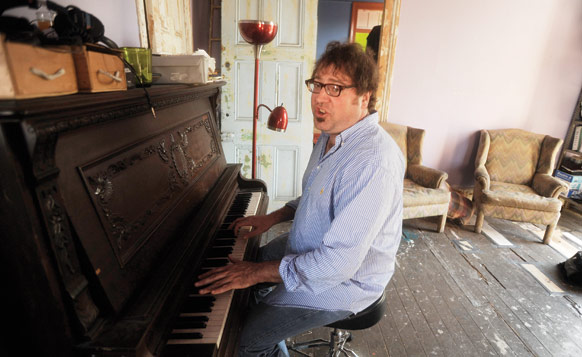
IRIS login | Reed College home Volume 90, No. 2: June 2011
The Showman’s Doppelganger (continued)

Photo by David Rae Morris
Lives in New Orleans are divided into two distinct phases: before and after Katrina. Davis is no exception.
Before the cataclysmic storm, Davis was doing what he has done for most of the 20 years since he graduated from Reed as an English major: teaching music in public schools, playing small nightclubs, leading a band with a revolving cast of notoriously independent sidemen, and living in a dilapidated two-story Victorian in Treme, which he bought in 1993 with a modest inheritance.
He enjoyed some success with a horn-driven funk-and-rap band called “All That,” but mostly it was a hand-to-mouth existence.
In 2003, Reed classmate Bruce Bennett ’90 moved to New Orleans to teach music at Tulane University. Bruce knew Davis from their Portland days. He remembered the lanky, scruffy, hyper-literate KRRC disc jockey trying to push New Orleans delicacies like chicory coffee and cheese grits. Or blaring the Meters from the window of his Westport dorm room strewn with Spanish moss and decorated with Jazz Fest posters. He also remembers Davis writing music for a seven-piece brass orchestra in composition class, and leading thesis parades with a sousaphone and bass drum–driven band.
“He was Davis,” Bruce says. “Articulate, literate, and always looking for a party.”
Nearly 15 years later, reunited with Bruce in New Orleans, Davis resumed the role he enjoyed when the two were at Reed: ambassador to the Big Easy. The two slurped raw oysters at local dive bars and ate boiled crawfish on the Mississippi River levee. They soaked up the city’s live music, from traditional jazz to genre-hopping underground party bands. While Bruce is more inclined toward symphonic electronica than Davis’s trademark style of classic R&B and novelty songwriting, the two found plenty of common ground. So much so that Davis recruited Bruce to mix and master his magnum opus, Once and Future DJ.
Davis had just put the finishing touches on the album as Katrina was heading into the Gulf of Mexico. He dropped the master disc in the mail just as the monster took an ominous turn and zeroed in on New Orleans, and fled to Houston in a cramped Toyota Corolla.
Unfortunately, after the levees broke and most of the city drowned, the disc never made it to the manufacturer in New Jersey. Davis’s masterpiece was just another casualty of Katrina, or would have been—except that Bruce had saved a copy on his hard drive, which he had hastily packed at 3 a.m. as he and his family evacuated during the storm’s approach. Eventually, Davis and Bruce tracked each other down amid the New Orleans diaspora and the album was recovered.
Good thing, too. The record generated great local buzz once people began trickling back to the waterlogged city, including the review in Offbeat that would catch David Simon’s eye.
Davis remembers the email that would change his life. It was summer 2006, and he was an artist in residence in France’s Loire Valley. At first, he was tempted to blow off the inquiry, thinking it was yet another journalist or researcher with a Katrina question. But once he recognized whom it was from, he realized it was his ticket back home.
“Despite being a Reed graduate, I’m an entertainer from New Orleans and I’m trying to get a break any way I can,” Davis said one night over a bowl of gumbo. “Any idiot who wants to make me rich and famous is OK in my book, but in this case, I’m fortunate to be working with television geniuses.”
Davis was eager to share his life story and New Orleans insights, but first he wanted to familiarize himself with Simon’s work. He faced a steep learning curve. Not only was he unfamiliar with The Wire, he didn’t own a TV and rarely watched any. Simon’s people sent him DVDs of the first few seasons, Davis borrowed a television, and, as he put it, “I was blown away. I was watching the work of a master storyteller.”
When Davis returned to New Orleans in the fall of 2006, Simon and his substantial creative entourage had already set up camp. Much of the city was still a mess, and the cleanup was bogged down in government ineptitude. But a hardscrabble recovery was being sparked by the city’s cultural institutions—food, music and celebration—and Davis jumped on the HBO tab for a whirlwind of wining, dining, second-line parades, and live music at storied hole-in-the-wall nightclubs.
At one long, languorous, and well-lubricated dinner, at Irene’s in the French Quarter, Davis was introduced to Eric Overmyer ’73. Neither of them knew about the other’s Reed connections until about half an hour into the meal, when Eric asked where Davis went to college. From there, they veered into nostalgia about the Doyle Owl (both claim sightings), professor Lisa Steinman [English 1976–] (mutual admiration) and the theatre department (each took the same playwriting class nearly two decades apart). Finally, it came time to talk about a contract. Davis thought to himself, “Are you kidding me? I’m having as much fun as I’ve ever had in my life, and I’m getting paid to show people around New Orleans and talk endlessly about myself.”
Negotiations were brief. Davis recalled saying, “I’ll tell you everything I know and I trust you’ll take care of me.” As a gesture of good faith, Simon placed one of his songs, “Do Me That Way,” in the fifth and final season of The Wire.
Simon has made good on his end of the deal. From the first season, Davis can reel off his credits with exacting detail: co-writer of episode No. 7, six lines of dialogue as his cameo character Rogan, an original jingle, and a portion of his song “Strippers,” which includes the immortal lines:
I got strippers moving in my neighborhood.
We can call it gentrification, but I call it good.


LATEST COMMENTS
steve-jobs-1976 I knew Steve Jobs when he was on the second floor of Quincy. (Fall...
Utnapishtim - 2 weeks ago
Prof. Mason Drukman [political science 1964–70] This is gold, pure gold. God bless, Prof. Drukman.
puredog - 1 month ago
virginia-davis-1965 Such a good friend & compatriot in the day of Satyricon...
czarchasm - 4 months ago
John Peara Baba 1990 John died of a broken heart from losing his mom and then his...
kodachrome - 7 months ago
Carol Sawyer 1962 Who wrote this obit? I'm writing something about Carol Sawyer...
MsLaurie Pepper - 8 months ago
William W. Wissman MAT 1969 ...and THREE sisters. Sabra, the oldest, Mary, the middle, and...
riclf - 10 months ago